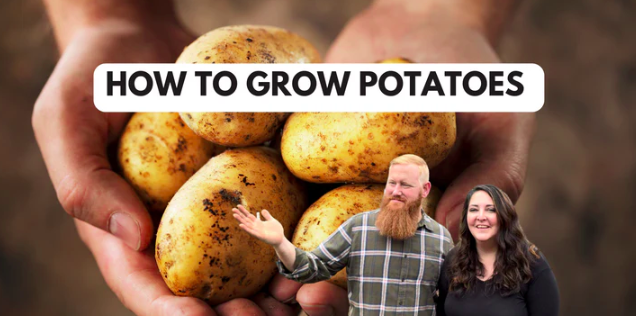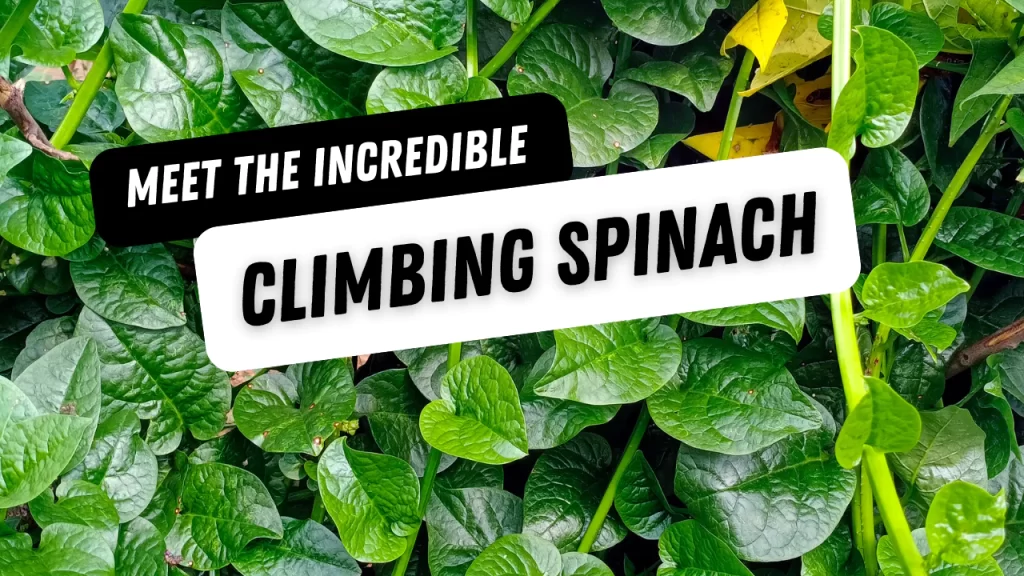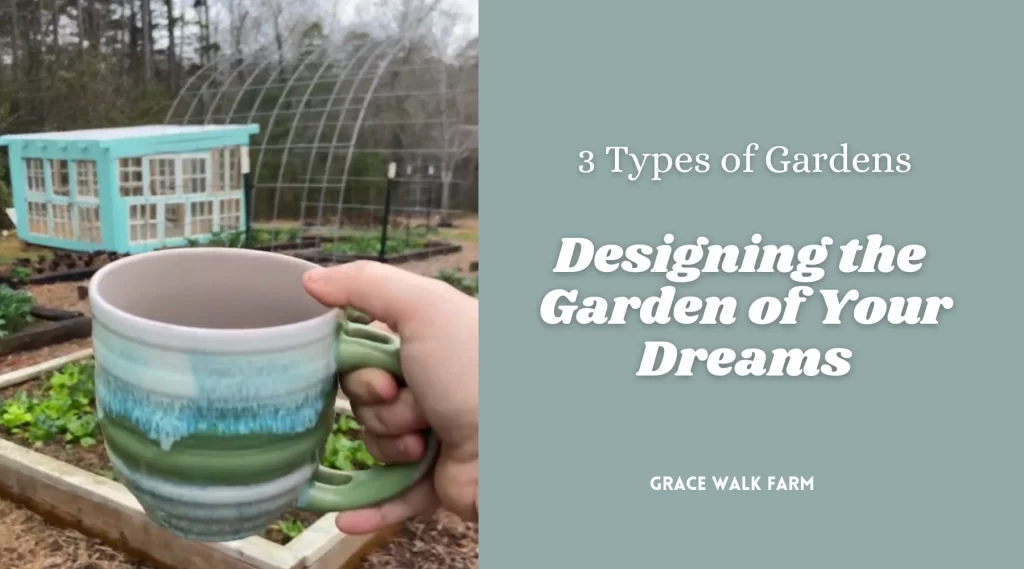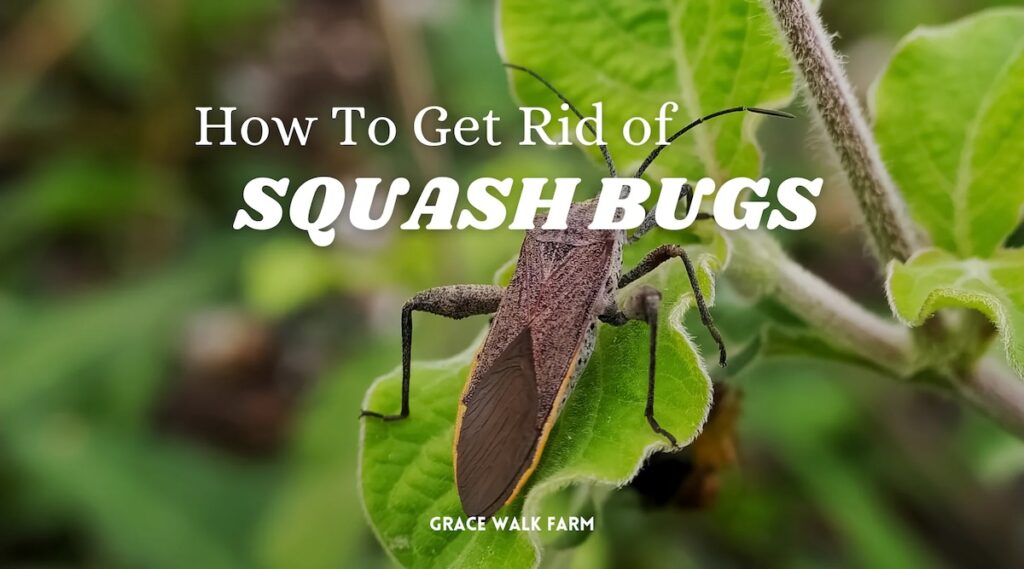Growing potatoes is a rewarding and fulfilling experience for any gardener. As a versatile and essential staple in many diets, potato gardens can be easily grown in a wide range of climates and soil types, making them a great choice for both beginner and experienced gardeners. Whether you have a large garden or just a few containers, there are many different ways to successfully grow potatoes and produce a bountiful harvest.
Welcome to Grace Walk Farm, our family homestead in western NC. We share the highs and lows of our homestead journey, in hopes that it will encourage you to grow your own food too. Click here to grab our Beginner Garden Guide for free! Join our 600K strong Instagram community of homesteaders here. Thanks for stopping by!
In this article, we will explore everything you need to know about growing potatoes, from selecting the right seed potatoes to planting, caring for, and harvesting your crop. We’ll also cover common problems that can arise when growing potatoes and provide tips for ensuring a successful harvest.

Choosing Seed Potatoes
Start by selecting seed potatoes, which are small whole potatoes or pieces of potatoes that are planted to produce a new crop. Choose seed potatoes that are firm and disease-free, and try to select varieties that are well-suited for your climate.
Potatoes can be categorized as either determinate or indeterminate, based on their growth habit. Determinate potato varieties have a compact growth habit and tend to produce all of their tubers at once, typically earlier in the growing season. They are often used for early-season harvests or for producing a large crop in a short period of time.
Indeterminate potato varieties, on the other hand, have a more sprawling growth habit and continue to produce new tubers throughout the growing season. They tend to produce a higher overall yield, but the tubers may be smaller than those produced by determinate varieties. Indeterminate potatoes are often used for longer-term storage and are more suitable for larger gardens or farms.
When deciding which type of potato to grow, it’s important to consider your goals and available space. If you have limited space or are looking for a quick crop, determinate potatoes may be the better choice. If you have more space and want a higher overall yield, indeterminate potatoes may be a better option. Ultimately, both types of potatoes can be delicious and nutritious, and it’s up to the gardener to decide which variety best meets

Prepare the Soil
Potatoes grow best in loose, well-draining soil that is rich in organic matter. Before planting, loosen the soil to a depth of 8-12 inches and amend it with compost or well-rotted manure. Potatoes like a rich soil so don’t skip this step.

How to Plant Seed Potatoes
Plant the seed potatoes about 4-6 inches deep and 12-18 inches apart, with the eyes facing up. Cover the potatoes with soil and water them thoroughly. Hill the potatoes: As the potato plants grow, mound soil around the stems to keep the developing tubers covered and protected from sunlight. This will help prevent the tubers from turning green and becoming bitter.
Water and Fertilize
Potatoes require regular watering and benefit from a balanced fertilizer applied during the growing season. Avoid overwatering, as this can lead to disease and rot. If you get a lot of rain, water less frequently.
When to Harvest Potatoes
Potatoes are usually ready to harvest when the plants have died back and the foliage has yellowed. Dig up the tubers carefully, being careful not to damage them, and allow them to dry in the sun for a day or two.

Common Problems with Growing Potatoes
Potato Diseases: Potatoes can be vulnerable to various diseases, including late blight, early blight, and scab. Symptoms can include leaf spots, tuber rot, and scabby patches on the tubers. To prevent diseases, plant disease resistant varieties and avoid planting in the same location year after year.
Potato Pests: There are several pests that can damage potato plants, including potato beetles, aphids, and wireworms. Use insecticidal sprays or organic pest control methods such as Neem oil or Diatomaceous Earth to manage infestations.
Environmental Factors: Potatoes can be sensitive to extreme heat or cold, drought, or excessive moisture. Try to plant your potatoes in welldraining soil, and water them regularly to ensure they have enough moisture.
Poor quality seed potatoes: Using poor quality or infected seed potatoes can lead to poor yields or disease problems. Make sure to purchase certified seed potatoes from a reputable supplier.
Nutrient deficiencies: Potatoes require adequate amounts of nitrogen, phosphorus, and potassium to grow and produce a healthy crop. Test your soil regularly and add fertilizer as needed to provide the necessary nutrients.

Companion Planting with Potatoes
Beans: Beans are nitrogen-fixing plants, meaning they absorb nitrogen from the air and convert it into a form that can be used by plants. This can help improve the soil fertility around the potato plants.
Corn: Corn can provide shade for potato plants during the hot summer months, which can help prevent sunscald on the tubers. Additionally, corn and potato plants tend to have different pest problems, so planting them together can help reduce the risk of insect infestations.
Peas: Peas are another nitrogen-fixing plant that can help improve the soil fertility around the potato plants. Additionally, peas and potatoes are both cool-season crops, so they can be grown together without competing for resources.
Nasturtiums: Nasturtiums are a great companion plant for potatoes because they repel aphids and other pests that can damage the potato plants. They also have shallow roots, which means they won’t compete with the potato plants for nutrients.
Marigolds: Marigolds are another plant that can help repel pests and improve soil health around potato plants. They also have a strong scent that can help mask the odor of the potatoes, which can attract pests.

How to Harvest and Store Potatoes
Harvesting: Potatoes are usually ready to be harvested when the leaves and stems of the plant begin to turn yellow and die back. Use a fork or spade to carefully dig up the potatoes from the soil. Be careful not to damage the potatoes or their skins while digging.
Curing: After harvesting, let the potatoes dry for a few hours to allow the skins to harden. Move the potatoes to a dark, cool, and well-ventilated area to cure for 1-2 weeks. This will help the skins thicken and protect the potatoes from damage and disease during storage.
Sorting: Once the potatoes are cured, sort them into three categories: seed potatoes (the largest and healthiest), table potatoes (the medium-sized ones), and potatoes that are too small or damaged to use.
Storage: Store the potatoes in a dark, cool place with good ventilation, such as a root cellar, basement, or garage. Avoid storing potatoes in areas that are too damp, as this can cause them to rot. Keep them in a single layer or loosely piled in a container, such as a basket or cardboard box. Check them regularly for any signs of spoilage and remove any potatoes that show signs of disease or rot.
How to Save Seeds for Potatoes
Choose your potatoes: Select the healthiest and most productive potatoes from your crop for seed potatoes. Look for firm, smooth, and unblemished tubers that are about the size of an egg or larger.
Cure the seed potatoes: Before storing, cure the seed potatoes in a dark, cool, and dry place for about two weeks. This will help the potatoes toughen up their skin and prepare them for storage.
Store the seed potatoes: After curing, store the seed potatoes in a cool, dark, and well ventilated place. A temperature of 40-50°F (4-10°C) is ideal for storing seed potatoes.
Avoid storing them in a damp or humid area, as this can cause the potatoes to rot or sprout prematurely.
Monitor the seed potatoes: Check the seed potatoes periodically for signs of sprouting or disease. Discard any potatoes that show signs of rot or mold.
Plant the seed potatoes: When it’s time to plant, cut the seed potatoes into pieces that each have one or two “eyes” or buds. Allow the cut pieces to dry for a few days before planting. Plant the seed potatoes in well-draining soil, about 4-6 inches deep, with the cut side down and the eyes facing up.
Best Potato Varieties for Beginner Gardeners
Yukon Gold: A versatile variety with a buttery texture, golden flesh, and thin skin. Yukon Gold is an all-purpose potato that is great for mashing, boiling, and baking.
Red Pontiac: A popular red-skinned potato with white flesh that is great for roasting, boiling, and making potato salad. Red Pontiac is known for its reliable yields and disease resistance.
Russet Burbank: The classic baking potato, Russet Burbank has a high starch content and a thick skin. This variety is great for baking, frying, and making French fries.
Fingerling Potatoes: These small, finger-shaped potatoes have a nutty flavor and firm texture. They are great for roasting and can be used in salads and other dishes.
All Blue: This striking blue-skinned potato has blue flesh and a mild, sweet flavor. All Blue is great for boiling and making potato chips.
Need more garden help? Grab our brand new “Grow Food: Backyard Gardening 101” course. With video lessons and a 260+ page book to guide you, you’ll have the best garden of your life. Send me pictures of those beautiful potatoes when you start harvesting!
Which variety of potato is your favorite? Tell me in the comments!
Don’t forget to save these tips! Hover over any image and then click “pin” to add it to your Pinterest board.
Also check out these blogs:




